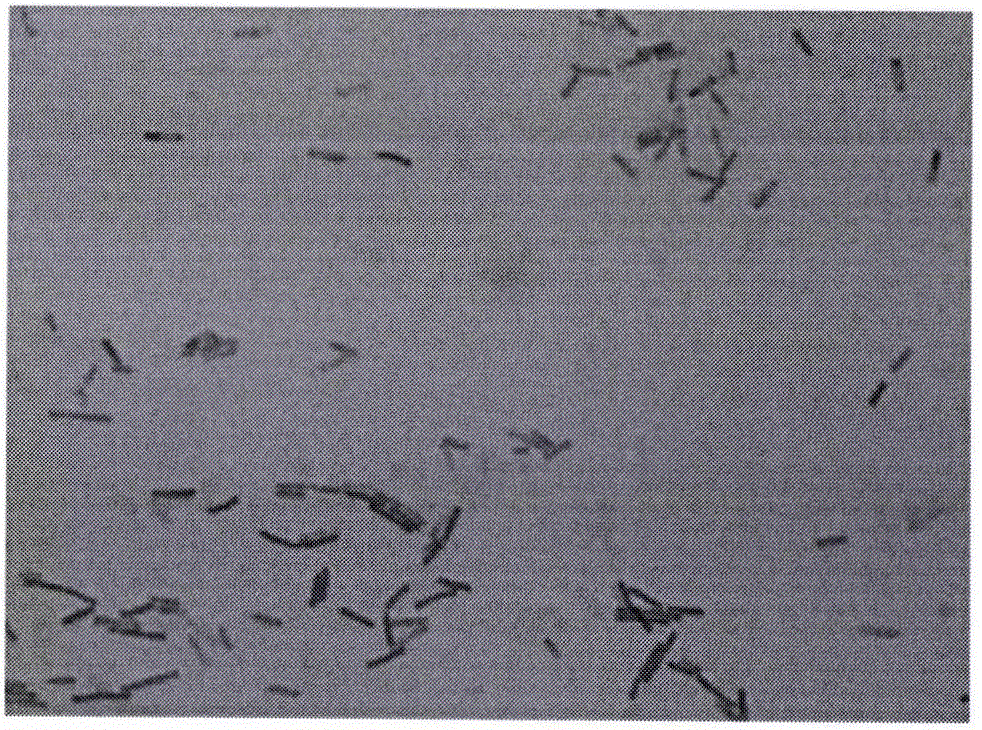Bacillus amyloliquefaciens subsp.plantarum and application thereof to scagassum biodegradation
A technology of bacillus and bacillus plants, applied in the field of microorganisms, can solve the problems of waste pollution of the environment and high energy consumption
- Summary
- Abstract
- Description
- Claims
- Application Information
AI Technical Summary
Problems solved by technology
Method used
Image
Examples
Embodiment 1
[0020] Example 1: Isolation of Bacillus HB12274 CGMCC No.12455
[0021] Sediment samples were collected from the mangrove forest in Dongzhai Port, Hainan Province by using the 5-point sampling method. Dissolve 10g of the sample in 90ml of sterile water, shake it in a constant temperature shaker at 37°C and 200r / min for 30min, let it stand for 5min, and prepare 10 -2 ~10 -4 series of soil suspensions. Use 80°C water bath for 20 minutes to kill non-spore-forming bacteria, draw 0.1ml of the series suspension, spread it on the bacteria isolation medium, and place it in a 37°C incubator for upside-down cultivation. When the colony grows, according to the phenotype characteristics such as colony shape, color, edge state, transparency, and surface dry and wet state, pick a single colony and purify it by streaking for 2 to 3 times until pure culture is obtained. After initial deduplication, number and save.
Embodiment 2
[0022] Example 2 Species Identification of Bacillus HB12274 CGMCC No.12455
[0023] (1) Morphology and culture characteristics
[0024] Streak culture of the strain on wort nutrient agar medium, the strain grows rapidly, the colony diameter is 3-5mm, round, with irregular edges, matte, uneven, milky white, opaque; the bacteria are long rod-shaped, Gram The result of Shi's staining was positive, producing spores, and one end was enlarged ( figure 1 ).
[0025] (2) Physiological and biochemical characteristics
[0026] Strain HB12274 can utilize glucose, sorbitol, maltose, sucrose, cellobiose, galactose, mannitol, fructose, lactose and arabinose. Gram staining, VP determination, contact enzyme test positive, MR test negative, can reduce nitrate, can make gelatin liquefaction.
[0027] (3) 16S rDNA sequence determination and phylogenetic analysis
[0028] The 16S rDNA sequence 1450bp of HB12274 was obtained by PCR amplification and sequencing, and the nucleotide sequence acc...
Embodiment 3
[0030] Embodiment 3: the preparation of strain HB12274 CGMCC No.12455 liquid bacterial agent
[0031] (1) Strain activation: the Bacillus amyloliquefaciens plant subsp. HB12274 was inoculated on a nutrient agar solid medium, and cultured at 37° C. for 24 hours. Medium: 10.0g peptone, 3.0g beef extract powder, 18.0g agar powder, 16.0g sodium chloride, 1000mL, pH7.5, sterilized at 121°C for 20min.
[0032] (2) Liquid culture: Inoculate the activated bacterial strain into a nutrient agar liquid medium, shake and culture at 37° C. and 200 r / min for 24 hours to prepare a seed liquid.
[0033](3) Fermentation culture: the seed liquid was inoculated into nutrient agar liquid medium at a volume ratio of 3%, and vibrated at 37° C. and 200 r / min for 72 hours to obtain a liquid bacterial preparation of Bacillus amyloliquefaciens subsp. HB12274.
[0034] According to the above steps, the liquid microbial agent of Bacillus amyloliquefaciens subspecies HB12274 is prepared.
PUM
 Login to View More
Login to View More Abstract
Description
Claims
Application Information
 Login to View More
Login to View More - R&D
- Intellectual Property
- Life Sciences
- Materials
- Tech Scout
- Unparalleled Data Quality
- Higher Quality Content
- 60% Fewer Hallucinations
Browse by: Latest US Patents, China's latest patents, Technical Efficacy Thesaurus, Application Domain, Technology Topic, Popular Technical Reports.
© 2025 PatSnap. All rights reserved.Legal|Privacy policy|Modern Slavery Act Transparency Statement|Sitemap|About US| Contact US: help@patsnap.com



